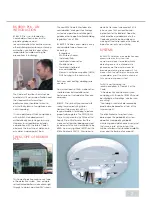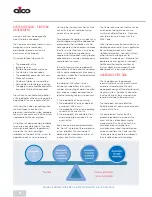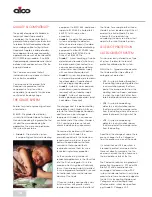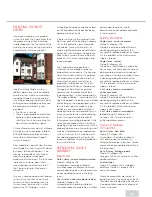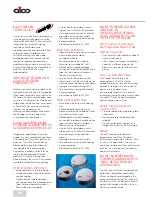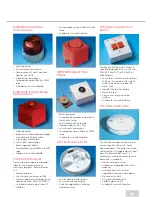
19
• Do not locate unit within 1m of
dimmer controlled lights and wiring
- some dimmers can cause
interference
• Do not wire into the same circuit as
a dimmer
• Do not locate unit within 1.5m, or
route wiring within 1m of fluorescent
light fittings as electrical “noise”
and/or flickering may affect the unit.
Do not wire into the same circuit as a
fluorescent light
• Do not locate ceiling mounted units
within 30cm of walls or corners
• Do not locate near very dusty or dirty
areas, as dust build-up in the
chamber can make the unit too
sensitive and prone to false alarm
• Do not locate in insect infested areas.
Small insects getting into the chamber
can cause intermittent alarms
TESTING & MAINTENANCE
Minimum monthly, recommended weekly
(i)
Check that the green mains indicator
light is on (if it is off check circuit
breakers, fuses and wiring)
(ii) Press the test button for at least ten
seconds to ensure that the smoke
chamber, electronics and sounder are
working and that all the alarms that
are interconnected are sounding. A
red light behind the test button, or on
the cover will flash rapidly while the
horn is sounding. The alarm will stop
soon after the button is released. Do
not test with a flame or smoke
(iii) Check for any sign of contamination
such as cobwebs or dust. Smoke
alarms must be cleaned regularly. This
is particularly true of optical alarms,
and alarms placed in dusty areas.
Use the narrow nozzle attachment of
a vacuum cleaner to remove dust,
insects or cobwebs from the sides
and cover slots where the smoke
enters. Turn off the mains and wipe
the cover with a damp cloth. Dry
cover thoroughly with a lint free
cloth. Other than the cleaning
described, no other customer
servicing of the product is required.
Repairs, when needed, must be
carried out by the manufacturer
(iv) Check the battery annually. Refer
to the specific user instructions
(v) Protect the alarm with the dust
cover supplied when any renovation
work or redecoration is being
carried out. Remove the cover
immediately when all work is
completed as the alarm will not
function correctly with the cover in
place. Alternatively, with ‘Easi-fit’
style alarms, simply remove the
detector head in the advised
manner
(vi) Do not paint an alarm or allow paint
to contaminate it when decorating
FALSE ALARMS
These can best be minimised by the
careful selection, siting and
maintenance of alarms. It is a good
idea to specify alarms with a ‘hush’
(false alarm control) button to
temporarily silence false alarms from
cooking vapours, steam or excessive
tobacco smoke, for example. This
facility will also help to reduce the risk of
users attempting to disable the alarm
by, for example, removing the battery or
tampering with the mains.
LIMITATIONS OF SMOKE
ALARMS
• Smoke alarms will not detect a
fire if sufficient smoke does not
reach the alarm. Smoke may be
prevented from reaching the alarm
if the fire is too far away or if the fire
is behind a closed door, in a
chimney or wall cavity for example,
or if prevailing draughts carry the
smoke away
• Installing smoke alarms in every
room, or a heat alarm in areas
where a smoke alarm is not suited,
will very significantly improve the
probability of early fire detection
• The alarm may not be heard. Once
installed in its intended location you
should check that you can hear the
alarm even with the door closed;
this is particularly important to test in
the bedroom. If it cannot be heard,
install more alarms. Remember
mains powered alarms must be
interconnected
• Smoke alarms may not detect every
type of fire early enough. As stated
earlier, ionisation alarms and optical
alarms respond differently to the
different types of fire. Fire caused by
escaping gas, violent explosions or
poor storage of flammable liquids
can spread too quickly for a smoke
alarm to give an early warning
• A heat alarm will not sense smoke
and will only trigger when the
ambient temperature reaches the
range 54°C to 62°C
• Smoke and heat alarms do not last
indefinitely. For example, a build up
of contamination can cause false
alarms, more so in the case of
optical smoke alarms. Over a
period, depending upon the
conditions, the electronic
components will degrade. For these
reasons, all manufacturers
recommend regular testing and
replacement after no more than
ten years



